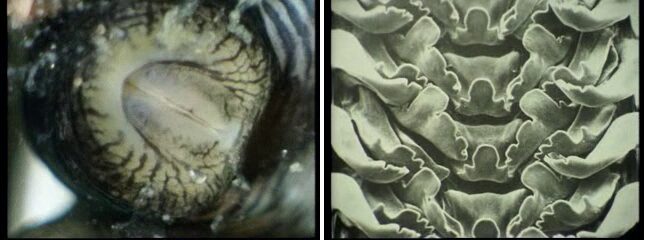Original air date : 23 January 1979
As the outline below indicates this programme looks rather like a normal natural history one. The mollusc part even has beautiful sequences as would be expected, but there are far more complicated sequences to film than a film crew would normally undertake as listed below.

The timeline shows how the episode progresses
This programme consists of many more animal groups (groupings) than the previous one, most (like flatworms) only briefly introduced. Only two groups take considerable time: molluscs (snails, slugs and relatives) starting almost 11 minutes into the programme and crabs (covering the last 10+ minutes). By coincidence both regions are bluish in colour).
The term “Experiments in animal design” are actually Attenborough’s own words. They were marked by very unusual body patterns that didn’t seem to be working.

A more detailed timeline of what goes on in the episode
A table look at a part of the screenshot above
A test to see how to adjust a table with some of the above information (from basic html coding, second table is based on a template):
| Time | Contents | Detailed contents |
| Until 6′ | Introduction | |
| Talks about fossils reflecting on the origin of life |
| Time | Contents | More detailed contents (location) |
| Until 6′ | Introduction | |
| 6′ | Attenborough appears | Talks about fossils reflecting on the origin of life (until 5’40) |
| 6′-8’30 | Flatworms | Absorb oxygen through their skin (6’40), being round became more feasible – all kinds of worms |
| 50’15-end | Attenborough appears | Introducing life on land – External skeleton … works just as well on land as it does in water (pre-adaptation) |
| 50’45 | Robber crab | (=Coconut crab) can breath on land – only has to go to sea to breed |
| 52’25-end | Coming up | Insects wrote the next chapter in the history of life on earth |
| 53’43 |
Selected material
There are several sequences of real beauties specifically among the swimming molluscs, but the following are more demanding for the cameramen.
A mollusc eating


Trilobites: For those unfamiliar with the group the one top left is a typical trilobite, top right shows several in a group (these were widespread animals). Some of the fossils were so good that their compact eyes would be preserved (bottom left) even to such a degree that their crystalline structure could be detected (bottom right).
X-ray images of fossilised trilobites (37’15-40′) and their connection to later technical solutions for optical lenses made by humans. See more on trilobites in First Life, Conquest.
A crab filmed moulting (45’30-46’12).

Filming locations
In Southern Australia, what presumably is his hand, can be seen picking up fossilised remains of a segmented worm (32’30).
Segmented worms were also found in the Rocky Mountains, British Columbia – Canada (33′-35′)
Horse shoe crabs at eastern seaboard of North America (40’40-43’25)
On a trawler off the coast of Japan (46′)
On the Great Barrier Reef (49′)